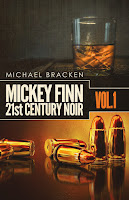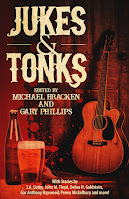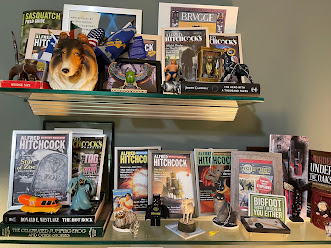Although there are some minor variations, editors of anthologies of original fiction find content in three primary ways:
Open Call. An open-call anthology is one for which anyone may submit.
Limited Open Call. A limited-open-call anthology is one for which only a limited number of people may submit, and how many writers are included in the limited call can vary from a few dozen to several hundred. For example, various Sisters in Crime chapters produce anthologies that allow submissions only from chapter members.
Invitation Only. An invitation-only anthology is one for which only writers who have been specifically invited may submit.
There are hybrid forms as well:
Invitation Only/Open Call Mix. The Bouchercon anthologies and several anthologies I’ve seen promoted via Kickstarter campaigns combine invitation-only, by which they acquire stories from a handful of well-known authors, and open-call, by which they acquire the balance of the content.
Invitation Only/Limited Open Call Mix. The Mystery Writers of America anthologies acquire a few stories via invitation and then have a limited open call for the balance of the content. In this case, the call is limited to MWA members.
ADVANTAGES and DISADVANTAGES
Each method has its advantages and disadvantages, and anthology editors must weigh the pros and cons of each when deciding how to approach any particular project.
The downside is that a widely announced anthology with an appealing theme might attract a great number of submissions of wildly variable quality and appropriateness, potentially overwhelming the editor.
Limited Open Call. The advantages and disadvantages of a limited-open-call anthology are quite dependent on which writers are included in the call. Limiting the call to writers with whom the editor has previously worked will likely result in submitted stories that meet or exceed the requirements, and it may prove difficult to narrow the selections.
On the flip side, the quality of submissions to a limited open call where the submission pool is defined by membership in a particular organization may be quite variable depending on the organization and, because the editor may not be able to seek submissions outside the defined pool, may require the editor to do more work bringing all the accepted stories up to snuff.
Invitation Only. From an editor’s standpoint, this may be the best way to assemble an anthology. By inviting only writers with whom the editor has previously worked and/or writers the editor admires, it almost guarantees that every submission will be appropriate. Almost.
The downside is that inevitably one or more of the invitees fails to deliver, and if the editor hasn’t planned ahead, this can lead to some last-minute scrambling to complete and deliver the project to the publisher on time.
REAL-WORLD EXAMPLES
I edited five open-call anthologies for Wildside Press and Betancourt & Company in the early 2000s and then spent several years randomly pitching anthology concepts that, at best, received “We like this, but” responses and, at worst, were completely ignored.
I returned to anthology editing in February 2017 when Down & Out Books greenlit The Eyes of Texas: Private Eyes from the Panhandle to the Piney Woods (2019). I’ve since edited and co-edited nine more (if I include the two due out later this month), and I’m in the process of editing or co-editing four due out in 2022, four tentatively due out in 2023, and one that does not yet have a release date because it does not yet have a publisher.
I have used all three methods (and some hybrid methods) to create these anthologies.
The Eyes of Texas: Private Eyes from the Panhandle to the Piney Woods (Down & Out Books, 2019) was an open-call anthology, though there was one exception. During a conversation at Bouchercon in Toronto I mentioned a specific historical event in Texas that I was surprised no writer had used in a story. That conversation turned into an invitation when the writer I was speaking with said he could use that event in a story.
Mickey Finn: 21st Century Noir, vol. 1 (Down & Out Books, 2020) was an Invitation Only/Open Call Mix. I invited four writers to submit and three of them did; the balance of the content came via open call. Mickey Finn: 21st Century Noir, vol. 2 (Down & Out Books, 2021), which was officially released yesterday, and MF3 (scheduled for 2022) were both open call. I recently released a limited open call for MF4 and have not yet decided if I’m going to switch to an open call.
Jukes & Tonks (Down & Out Books, 2021), co-edited with Gary Phillips, was invitation only. We each wrote a story and invited five other writers, for a total of twelve contributors. I don’t know how Gary chose his five, but my five were all writers with whom I had previously worked, that I knew could deliver what I wanted to see when I wanted to see it, and who I thought had at least a passing familiarity with the anthology’s theme.
Guns + Tacos (Down & Out Books), a serial novella anthology series co-created and co-edited with Trey R. Barker is an anomaly. Each novella is released as a separate e-book. Ultimately, though, all of the the novellas are gathered into three-novella anthologies. Volumes 1 and 2 were published in 2019, volumes 3 and 4 in 2020, volumes 5 and 6 later this month, and volumes 7 and 8 will appear in 2022. Guns + Tacos is invitation only, and Trey and I arm wrestle each year over which writers to invite. If there are additional entries in the G+T series, they will continue to be by invitation only.
Groovy Gumshoes: Private Eyes in the Psychedelic Sixties (due out April 2022) began as a single open-call anthology. I received more good stories than I could fit into a single volume, so I held back—with contributors’ approval—enough for a second volume with no assurance that there would even be a second volume. By the time Down & Out Books greenlit the second volume—More Groovy Gumshoes (due out in April 2023)—I’d lost a few stories to other publications. So, I invited two writers to come aboard at the last minute, making More Groovy Gumshoes an Invitation Only/Open Call Mix.
The other projects—which will go unnamed—include two invitation-only anthologies and a limited-open-call anthology I am co-editing.
DECIDING WHICH APPROACH
If you’ve worked your way through the above overview of the various anthologies I have edited or am in the process of editing, you’ll note that I’ve slowly moved away from open-call anthologies toward invitation-only anthologies, with a few hybrids along the way.
There are two key reasons for this decision:
Success. It is, perhaps, egotistical to say this, but the first two anthologies I edited since returning to this side of the editorial desk resulted in an Anthony Award nomination for Best Anthology, six stories receiving or nominated for major awards, and two stories included or long-listed for inclusion in a best-of-year anthology. Writers want to submit to editors with this kind of track record, so the number of submissions has increased substantially with each new open-call project.
Other editorial responsibilities. As editor of Black Cat Mystery Magazine, which remains an open-call project, I read a significant number of submissions from writers of all experience levels and across all the crime fiction subgenres. (See “Killing Dreams One Rejection at a Time, the Sequel” for a glimpse at what it’s like evaluating 264 submissions.) Thus, I am exposed to, and have the opportunity to work with, many new and new-to-me writers.
So, to reduce my workload without reducing the number of projects I edit, I’m increasingly relying on limited-invitation calls and personal invitations to acquire content.
MAKING AN EDITOR’S INVITATION LIST
These days, I appreciate it when I’m asked to contribute to an anthology, but early in my career I had no idea how to get on an editor’s invitation list. The first few times I was approached I had no idea how the editor selected me. (See “Pay It Forward” to learn how I was invited to contribute to Max Allan Collins and Jeff Gelb’s Flesh and Blood: Guilty as Sin.) That, combined with the number of times I’ve seen beginning and early career writers asking the same questions I’d once had, leads me to offer a few suggestions.
Write, Submit, and Get Published. If you’ve never been published, it’s highly unlikely you’ll ever be invited to submit to an anthology. So, write, submit what you write, and improve your skills. Once your work is being accepted on a regular basis via open-call projects, create a formal or informal list of all the editors you’ve worked with and would like to work with again. Then cross-reference that list with editors of invitation-only projects to determine where you might have opportunities to step up your game.
Be Professional and Easy to Work With. I wish this didn’t have to be restated, but, unless you’re a creative genius, your work will be edited. Meet deadlines at every step of a project. You must complete ancillary paperwork—contracts, author bios, story blurbs—so be available and easily reached via mail, email, and telephone. Understand how to use Microsoft Word.
If you have proven yourself professional and easy to work with on an open-call project, you increase your odds of being added to that editor’s list of potential writers for future invitation-only projects.
Make Your Desire Known. This last suggestion requires a bit of finesse. Do it wrong and you look like a suck-up. Do it right and your opportunities increase.
If you have worked with an editor, enjoyed the process, and would like to work with that editor again, let the editor know. A simple email stating something like: “I enjoyed working with you on Project X and would appreciate the opportunity to work with you again. Please keep me in mind for future projects.” I regularly work with writers who have sent me similar emails.
If there’s an editor you think you would like to work with, you can send a similar email: “Although we’ve not previously worked together, I have enjoyed reading Project X, Project Y, and Project Z. I write in the same subgenre, my work has appeared in Magazine A and Magazine B, and I would welcome the opportunity to be considered for one of your future projects.” One of the contributors to the Guns + Tacos series approached Trey and I with a similar email.
If you do these three things, you will increase your odds of having your work included in an invitation-only anthology. If you write a great story, act professionally, and let the editor know you’re interested in doing it again, odds are great that your name will be included on that editor’s list of “writers to work with again.”
CONCLUSION
If I receive several hundred emails today from writers who want to be included on my invitation list for future projects, I’m going to put y’all on my suck-up list. You need to wait long enough for me to forget I wrote this so that I’ll think your emails are truly heartfelt.
And if nobody sends me an email about this, I’m going to have to rethink my entire approach to editing.
My “Christmas Enchiladas and a Gold-Plated Derringer” was the bonus story for subscribers to Season 3 of Guns + Tacos, and it accompanied Andrew Welsh-Huggins’s “A Smith & Wesson with a Side of Chorizo.”








































